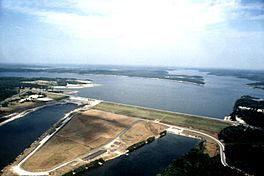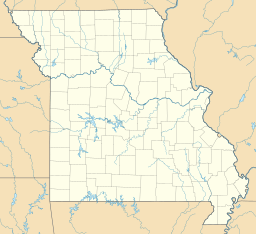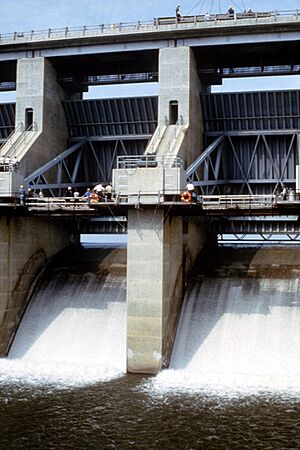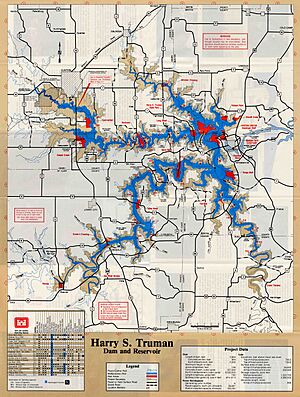Truman Reservoir facts for kids
Quick facts for kids Harry S. Truman Reservoir |
|
|---|---|
| Truman Lake | |

Harry S. Truman Dam and Reservoir
|
|
| Location | Benton, Henry, Hickory, and St. Clair counties, Missouri, U.S. |
| Coordinates | 38°15′47″N 93°24′17″W / 38.26306°N 93.40472°W |
| Type | Reservoir |
| Etymology | U.S. President Harry S. Truman |
| Primary inflows | Osage River |
| Primary outflows | Osage River |
| Basin countries | United States |
| Managing agency | U.S. Army Corps of Engineers |
| Surface area | 55,600 acres (225 km2), or 200,000 acres (810 km2) at flood stage |
| Average depth | 20 feet (6.1 m) |
| Max. depth | 80 feet (24 m) |
| Water volume | 5,000,000 acre⋅ft (6.2 km3) |
| Shore length1 | 958 miles (1,542 km) |
| Surface elevation | 706 feet (215 m) above sea level. |
| Settlements | |
| 1 Shore length is not a well-defined measure. | |
The Harry S. Truman Dam and Reservoir, also known as Truman Lake, is a large and important lake in Missouri, United States. It's located between the towns of Clinton and Warsaw, and stretches south to Osceola. This huge lake was created on the Osage River.
The dam itself is in Benton County. However, the reservoir, which is the lake, also reaches into parts of Henry, St. Clair, and Hickory counties. Truman Lake is a great place for outdoor fun and helps manage water for the area.
Contents
Building Truman Lake: A Look Back
The U.S. Army Corps of Engineers built and still manages Truman Lake and its dam. Its main job is to control floods, which helps protect nearby towns and farms. The lake also helps create electricity, offers many fun activities, and protects wildlife.
How the Lake Got Its Name
When the project was first approved in 1954, it was called the Kaysinger Bluff Dam and Reservoir. Construction started in August 1964. In 1970, the U.S. Congress decided to rename it. They chose Harry S. Truman Dam and Reservoir to honor Harry S. Truman, a former president who was from Missouri. The dam was finally finished in 1979.
The original name, Kaysinger Bluff, came from a tall cliff right next to where the dam was built. This bluff was a well-known landmark even before the lake existed. Today, the visitor center sits on top of this historic bluff.
Making Way for the Lake
Building Truman Lake was a massive project that took many years. It involved careful planning and buying land from many owners. New bridges had to be built, and old ones were taken down. Several roads, towns, and even cemeteries needed to be moved to higher ground.
One of the first big jobs was moving Route 13. This was done to make sure the road would stay above the water, even when the lake was at its highest level.
The rising water also affected railroads. The Frisco Railroad's "Highline" had to close because the tracks were cut off by the lake near Osceola and Deepwater. However, another railroad, the Missouri-Kansas-Texas Railroad, did move its main line. They built five miles of new track and a special bridge over the lake.
Harry S Truman Regional Visitor Center
The Harry S. Truman Visitor Center is a great place to learn about the lake. It has exhibits that tell the story of Truman Lake's history and nature. You can also learn about how the dam was built and how it makes electricity.
The center has a theater where you can watch videos about wildlife, history, and water safety. From the observation deck, you get amazing views of Truman Lake, part of the Lake of the Ozarks, and the dam itself.
Harry S Truman State Park
If you love the outdoors, you can visit Harry S Truman State Park. It's located in Benton County, Missouri on a piece of land that sticks out into the reservoir. It's a perfect spot for camping, fishing, and hiking.
Weaubleau-Osceola Structure: An Ancient Impact
The southwest part of Truman Lake covers an interesting geological feature. It's part of the Weaubleau-Osceola structure, which is a very old impact crater. This crater was formed about 330 to 335 million years ago when something from space crashed into Earth!
Facts About the Harry S. Truman Dam
The Harry S. Truman Dam is an impressive structure.
- It is made of two parts: a concrete section and an earth embankment.
- The total length of the dam is about 5,964 feet (1,818 meters).
- The concrete part is 964 feet (294 meters) long.
- The earth part stretches for 5,000 feet (1,524 meters).
- The dam stands about 126 feet (38 meters) above the river bed.
- It contains a huge amount of material: 327,000 cubic yards (250,011 cubic meters) of concrete and 8,500,000 cubic yards (6,498,755 cubic meters) of earth.
- The Spillway is 190 feet (58 meters) long and has four sections.
- There are four large tainter gates that control water flow.
- The dam has six turbines that can generate 160 megawatts of electricity.





